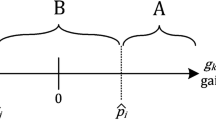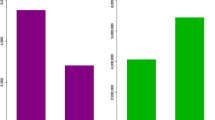Abstract
In contrast to the bulk of the campaign finance literature that highlights political action committee (PAC) contributions and single donations, this paper emphasizes soft money and the rationale for dual contributions. Employing a formal model of unregulated contributions and political access, we show that donors will rationally choose to contribute to both political parties. While the parties accept these dual contributions, they lead to an imbalance between the benefits of contributions and the costs of providing access. This race to acquire unlimited soft money leads to a situation where the parties agree to campaign finance reform legislation.
Similar content being viewed by others
References
Abreu, D., Dutta, P. K., & Smith, L. (1994). The folk theorem for repeated games: A NEU condition. Econometrica, 62(4), 939–948.
Alesina, A., & Spear, S. E. (1988). An overlapping generations model of electoral competition. Journal of Public Economics, 37(3), 359–379.
Anonymous (1998). Soft money: The current rules and the case for reform. Harvard Law Review, 111(5), 1323–1340.
Austen-Smith, D. (1987). Interest groups, campaign contributions and probabilistic voting. Public Choice, 54(2), 123–139.
Austen-Smith, D. (1995). Campaign contributions and access. American Political Science Review, 89(3), 566–581.
Austen-Smith, D., & Banks, J. (1989). Electoral accountability and incumbency. In P. Ordeshook (Ed.), Models of strategic choice in politics (pp. 121–148). Ann Arbour: University of Michigan Press.
Baron, D. P. (1989a). Service-induced campaign contributions and the electoral equilibrium. Quarterly Journal of Economics, 104(1), 45–72.
Baron, D. P. (1989b). Service-induced campaign contributions, incumbent shirking, and reelection opportunities. In P. Ordeshook (Ed.), Models of strategic choice in politics (pp. 93–120). Ann Arbour: University of Michigan Press.
Baron, D. P. (1994). Electoral competition with informed and uninformed voters. American Political Science Review, 88(1), 33–47.
Barro, R. J. (1973). The control of politicians: An economic model. Public Choice, 14, 19–42.
Cantor, D. M., & Herrnson, P. S. (1997). Party campaign activity and party unity in the U.S. house of representatives. Legislative Studies Quarterly, 22(3), 393–415.
Common Cause. (2001). The half billion dollar shakedown: Appendix. Retrieved May 14, 2003, from http://www.commoncause.org/publications/april01/softmoney/appendix. pdf
Common Cause. (2002). National parties raise $160.1 million of soft money in 2001; shattering previous fundraising records for first year of an election cycle. Retrieved July 2, 2002, from http://www.commoncause.org/shaysmeehan/2001totals.htm
Cremer, J. (1986). Cooperation in ongoing organizations. Quarterly Journal of Economics, 101(1), 33–50.
Dal Bo, E. (2000). Bribing voters (Department of Economics Working Paper, 39), University of Oxford.
FEC. (1995). FEC twenty year report. Retrieved October 3, 2002, from http://fecweb1.fec.gov/pages/20year.htm
FEC. (2002). National party non-federal activity: Through twenty days after the general election. Retrieved May 14, 2003, from www.fec.gov/press/20021218party/ nonfederalsummary.xls
Grossman, G. M., & Helpman, E. (1996). Electoral competition and special interest politics. Review of Economic Studies, 63(2), 265–286.
Herndon, J. F. (1982). Access, record, and competition as influences on interest group contributions to congressional campaigns. Journal of Politics, 44(4), 996–1019.
Hinich, M. J., & Munger, M. C. (1989). Political investment, voter perceptions, and candidate strategy: An equilibrium spatial analysis. In P. Ordeshook (Ed.), Models of strategic choice in politics (pp. 49–67). Ann Arbour: University of Michigan Press.
McCarty, N., & Rothenberg, L. (1996). Commitment and the campaign contribution contract. American Journal of Political Science, 40(3), 872–904.
Mitchell, A. (2002). Law’s sponsors fault draft of campaign finance rules. New York Times
Morton, R., & Cameron, C. (1992). Elections and the theory of campaign contributions: A survey and critical analysis. Economics and Politics, 4(1), 79–108.
Mosk, M. (2002). Circumventing money limits in Md. campaigns: Donors can contribute funds to parties’ special accounts. Washington Post
Nichols, J. (2002). Campaign finance: The sequel. The Nation, (29), 16–20.
Oppel, R. A., Jr. (2002, September 30). Records falling in waning days of soft money. New York Times
Prat, A. (2002). Campaign spending with office-seeking politicians, rational voters, and multiple lobbies. Journal of Economic Theory, 103(1), 162–189.
Sabato, L. J. (1985). PAC power: Inside the world of political action committees. New York: Norton.
Sen. Corzine (NJ). (2002). Bipartisan Campaign Reform Act of 2002. Congressional Record (Daily ed.) p. S2152.
Sen. Feinstein (CA). (2002). Bipartisan Campaign Reform Act of 2002. Congressional Record (Daily ed.) p. S2153.
Sen. Grassley (IA). (2002). Bipartisan Campaign Reform Act of 2002. Congressional Record (Daily ed.) p. S2112.
Sen. Levin (MI). (2002). Bipartisan Campaign Reform Act of 2002. Congressional Record (Daily ed.) p. S2115.
Sen. McConnell (KY). (2002). Bipartisan Campaign Reform Act of 2002. Congressional Record (Daily ed.) p. S2121.
Sen. Schumer (NY). (2002). Bipartisan Campaign Reform Act of 2002. Congressional Record (Daily ed.) p. S2111.
Sen. Thompson (TN). (2002). Bipartisan Campaign Reform Act of 2002. Congressional Record (Daily ed.) p. S2110.
Sloof, R., & van Winden, F. (2000). Show them your teeth first! A game-theoretic analysis of lobbying and pressure. Public Choice, 104(1–2), 81–120.
Snyder, J. M. (1990). Campaign contributions as investments: The U.S. House of Representatives, 1980–1986. Journal of Political Economy, 98(6), 1195–1227.
Snyder, J. M. (1993). The market for campaign contributions: Evidence for the U.S. senate 1980–1986. Economics and Politics, 5(3), 219–240.
Snyder, J. M., & Groseclose, T. (2000). Estimating party influence in congressional roll-call voting. American Journal of Political Science, 44(2), 193–211.
Van Natta, D., Jr. (2002). Cheney argues against giving congress records. New York Times
Waller, D. (2002). Looking for the loopholes. Time, 159, 42–43.
Welch, W. P. (1980). The allocation of political monies: Economic interest groups. Public Choice, 35(1), 97–120.
Woellert, L., & Dwyer, P. (2002). Soft money: Is it the end—or the end run? Business Week, 3790, p. 47.
Author information
Authors and Affiliations
Corresponding author
Rights and permissions
About this article
Cite this article
Gill, D., Lipsmeyer, C.S. Soft money and hard choices: Why political parties might legislate against soft money donations. Public Choice 123, 411–438 (2005). https://doi.org/10.1007/s11127-005-7169-y
Accepted:
Issue Date:
DOI: https://doi.org/10.1007/s11127-005-7169-y




